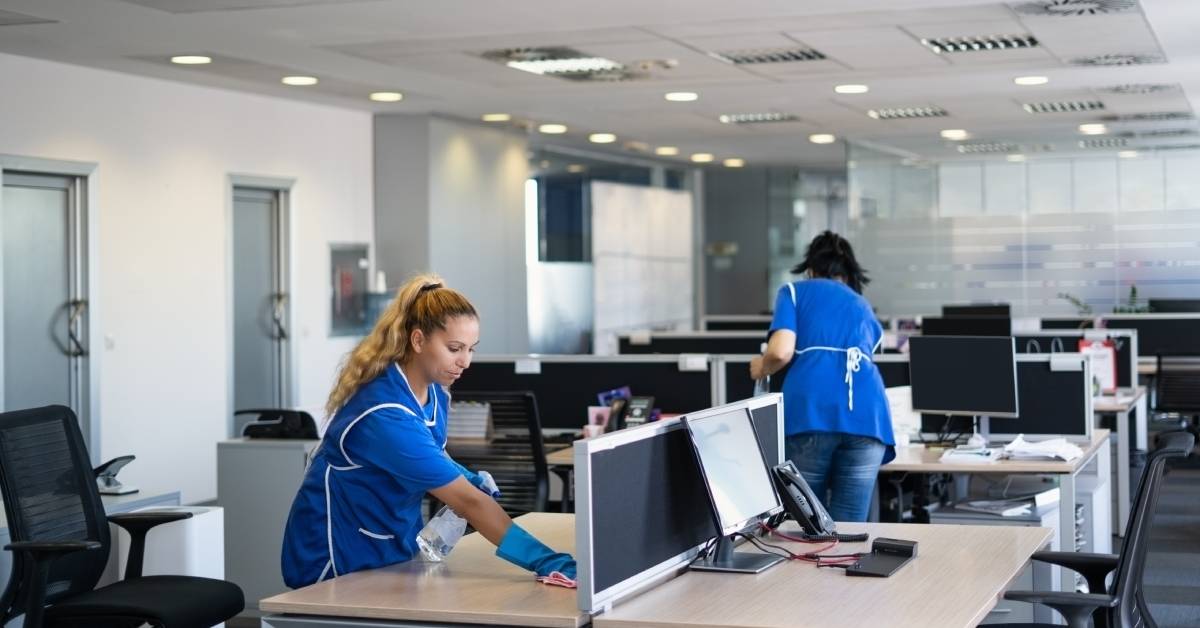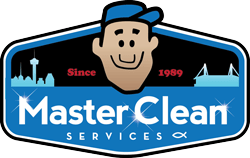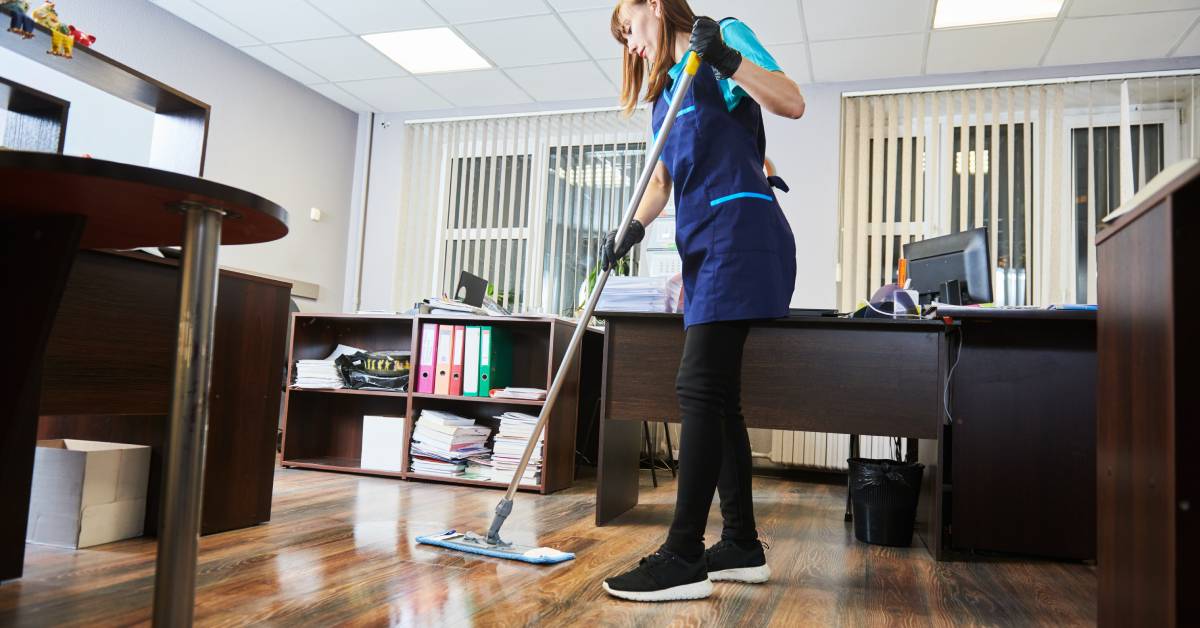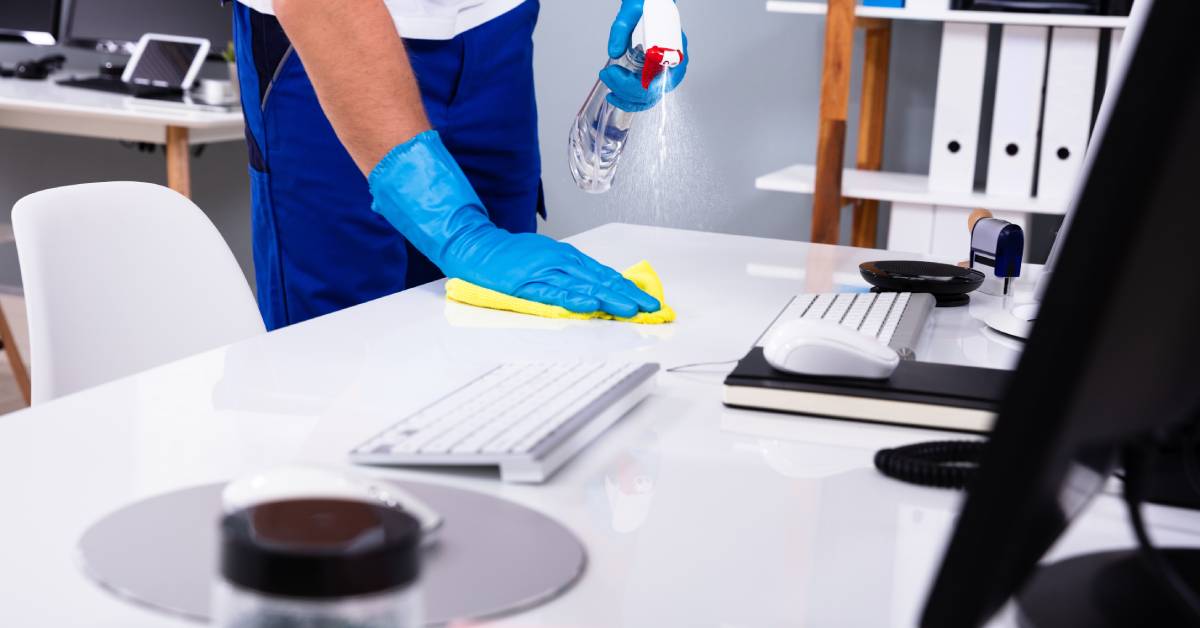
13 Aug How Regular Cleaning Helps Prevent Workplace Accidents
Maintaining a safe and productive workplace is a top priority for property managers of office buildings. One critical yet often overlooked aspect of maintaining such a space is cleanliness. A clean office is not just about aesthetics or first impressions; it directly impacts the health, safety, and well-being of employees, tenants, and visitors.
Frequent and thorough cleaning helps eliminate hazards that can lead to workplace accidents, creating a safer environment for everyone. For office managers, understanding how regular cleaning helps prevent workplace accidents is essential to fostering safety in office buildings.
The Link Between Cleanliness and Workplace Safety
A cluttered or dirty workspace can quickly become a breeding ground for accidents. Slippery floors caused by spills, obstructed pathways due to debris, and poorly maintained infrastructure contribute to workplace injuries and incidents. The Occupational Safety and Health Administration (OSHA) cites slips, trips, and falls as some of the most common causes of workplace accidents. Many of these incidents are preventable through routine cleaning and maintenance.
When offices are not cleaned regularly, dirt, dust, and moisture accumulate on floors and surfaces. These conditions increase the risk of slipping or falling, which can result in anything from minor bruises to severe injuries such as fractures or concussions. Additionally, disorganized workspaces can lead to tripping hazards if loose wires, boxes, or other objects clutter walkways. By maintaining cleanliness, property managers can reduce these risks and provide a safer environment.
Mitigating Slip, Trip, and Fall Hazards
Wet floors remain one of the leading causes of slips and falls in workplaces. Whether from spilled coffee in the breakroom, rainwater brought in on shoes, or leaks from plumbing issues, moisture on floors can quickly cause accidents if not addressed promptly. Regular cleaning routines that include mopping and drying high-traffic areas are essential to keeping floors safe.
Routine inspections and cleaning schedules also minimize the risk of trip hazards. Ensuring walkways are clear of cords, misplaced furniture, and other obstructions allows employees and visitors to move about safely. Encouraging tenants to properly store office supplies and equipment also plays a role in avoiding unnecessary clutter.
To further reduce risks, employing proper signage during cleaning operations is critical. “Wet Floor” signs are a simple yet effective way to alert employees and visitors to potential hazards within office corridors or common areas.
Improving Indoor Air Quality
It’s not just surfaces and floors that need attention; air quality plays a significant role in workplace safety and health. Dust, allergens, and pollutants often accumulate in office environments, particularly in areas like air vents, carpets, and upholstery. Poor indoor air quality can lead to respiratory problems and allergic reactions, creating unsafe working conditions for employees who are sensitive or asthmatic.
Regular cleaning that targets dust, mold, and other airborne contaminants ensures safer indoor air quality. Office managers should prioritize vacuuming carpets, cleaning air ducts, and routinely sanitizing high-touch areas. Partnering with a professional office cleaning company with advanced tools, such as HEPA vacuum cleaners, is also ideal to effectively remove allergens. The benefits of maintaining superior air quality include fewer sick days among employees, better productivity, and a healthier workforce overall.
Preventing Fire Hazards
Workplace cleanliness extends beyond minimizing slips and falls to addressing fire hazards. Cluttered spaces that store excessive paper, cardboard, or other flammable materials increase the risk of fires. Additionally, dust and grime buildup in electronic equipment and appliances can lead to overheating or malfunctioning, which could spark a fire.
Regular cleaning reduces the accumulation of fire-prone materials throughout the office. Entrusting cleaning personnel with tasks such as clearing paper waste, properly storing chemicals, and ensuring electrical equipment is free of dust accumulation can significantly mitigate fire risks. Office managers overseeing office buildings must also ensure that cleaning teams periodically clean storage areas, garbage bins, and utility rooms, all spaces that are prone to neglect but essential to fire safety.
Enhancing Hygiene and Preventing Workplace Illnesses
Workplace accidents aren’t limited to physical injuries. Illnesses caused by unsanitary conditions can also compromise employee safety and disrupt business operations. Germs and bacteria thrive in dirty environments, especially in communal spaces like kitchens, restrooms, and shared workstations. Contaminated surfaces, such as keyboards, doorknobs, and elevator buttons, become hotspots for the transmission of illnesses.
Regular disinfection of high-touch surfaces plays a critical role in minimizing the spread of germs throughout the office. Employing professional cleaners who specialize in sanitization ensures that these areas receive the necessary attention to maintain a safe and hygienic environment. Property managers can also collaborate with cleaning contractors to provide hand sanitizing stations in common areas, further encouraging good hygiene practices among tenants.
Implementing an Effective Cleaning Schedule
For a cleaning regimen to be effective in preventing accidents, it must be both thorough and consistent. Developing a structured cleaning schedule tailored to the specific needs of the building is key. Property managers should consider factors such as building size, occupancy, and the nature of the office activities to determine cleaning frequency and focus areas. Some best practices include:
- Daily cleaning: Routine cleaning tasks should target high-traffic areas like lobbies, hallways, restrooms, and kitchens. This includes vacuuming, mopping, disinfecting surfaces, and emptying trash receptacles.
- Weekly cleaning: Conduct more detailed cleaning operations, such as deep-cleaning carpets, scrubbing bathroom tiles, and wiping down windows and walls.
- Monthly cleaning: Undertake infrastructure checks, including HVAC maintenance and appliance cleaning, to address hidden areas where dirt and contaminants may accumulate.
- Seasonal cleaning: Inspect exterior premises for seasonal hazards such as wet leaves, ice, or debris that could increase workplace accident risks.
Partnering with a professional cleaning service that understands your building’s needs ensures the development and execution of a comprehensive cleaning plan, enabling property managers to efficiently maintain workplace safety.
Cultivating a Culture of Safety
Establishing regular cleaning practices is just one part of the larger effort to promote safety in the workplace. Property managers should work closely with tenants to cultivate a culture of safety and cleanliness. Encouraging employees to report spills or hazards promptly, maintain organized workstations, and follow hygiene protocols contributes to the cleanliness of the office environment.
Offering periodic reminders about proper waste disposal, storage practices, and general housekeeping enhances collaboration between cleaning teams and building occupants. Safety training sessions, which include discussions on the importance of cleanliness in accident prevention, also reinforce the shared responsibility for maintaining a hazard-free workplace.
The Value of Regular Cleaning for Property Managers
For office managers, investing in regular cleaning goes beyond accident prevention—it fosters tenant satisfaction and retention. A clean and safe office environment enhances the overall experience for those who work or visit the building. Tenants are more likely to renew their leases when they feel confident in the property manager’s commitment to safety and maintenance.
Additionally, reducing accidents and illnesses through effective cleaning lowers the risk of liability issues. By demonstrating proactive measures to prioritize workplace safety, property managers protect not only the physical environment of the office but also their reputation and long-term financial stability.
Keep Your Office Clean
Knowing how routine cleaning helps prevent workplace accidents ensures the safety of office-building occupants. By addressing hazards such as wet floors, obstructions, poor air quality, and unsanitary conditions, property managers can create an environment that minimizes risks and promotes tenant well-being.



